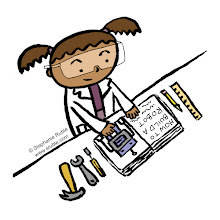Shaun Tan: I was lucky to be able to see Shaun at the Illustrator’s Intensive and at the main conference. (Note: I’ve combined both of his sessions here.) His latest book, THE BIRD KING, a compilation of sketches, artwork, and commentary from Shaun about his work, was just released. One of my favorite things about his new book is some of the influences for his art and how that turned into characters for his books. His art is amazing and it was cool to see his process and hear him talk about creativity.
- Style emerges from visual experiences.
- Style is more about how you think and solve problems, that
defines who you are, and less about medium and how you use it.
- Style is like personality.
- Stories that migrate are universal (TALES FROM OUTER
SUBURBIA).
- THE ARRIVAL started as a 32 pg. picture book and was
influenced by the work of Raymond Briggs (THE SNOWMAN and WHERE THE WIND BLOWS)
- Wasn’t into comics before THE ARRIVAL. He had to learn how
to draw them while doing the book.
- Doesn’t ask if it’s a PB, GN, or short story. Just thinks
it’s a good idea.
- You don’t need to tell a story to tell a story. Let the
reader do the work.
David Ezra Stein: His new book OL’ MAMA SQUIRREL is out in March – only a short time to
wait! He talked about the process of creating the characters and book. Can’t
wait to see it when it comes out!
- Only you can make art the way you do it.
- “The secret was getting the right nose for the squirrel.”
(Talking about his new book, and how he did all the art over after submitting
final art to the publisher. The old art was good, but the new art was great.
And it has the new nose. It reminds him of a periscope, or a tater tot.)
- On re-doing all the art: he said that he should have kept
going with the character sketches in the beginning instead of just picking a
squirrel he kind-of liked.
- Listen to your ideas. Turn off the TV. Write the ideas
down. Doodle!
- When working digitally, the ICC profile from the printer
can be loaded into Photoshop to help you see what the printed art will look
like. You also might have to turn the monitor down.
- The actual book itself is the art, not the painting or
what’s on your computer.
- When the color looks bad (too bright and garish) it’s
probably good (for printing). Or at least this was true for their art for this
book.
- The work is the most important thing. (He doesn’t do book
fairs, school visits, blog, etc. He says he’s a bit of a hermit.)
- “You can do anything, absolutely anything, as long as you
can make it work.”
- On picture books for very little kids (like FIREHOUSE!
which is a sequel to FUNNY FARM): The pictures do the work and the text is not
as important. You need strong characters and a simple story.
- “One of the really most important aspects of a PB is when
you turn the page.”
- Starts with acrylics for under painting, then paints
layers of water soluble oils on watercolor blocks (so he doesn’t have to
stretch paper) for the finished art.
- It takes him 3-5 days to do an image. The whole book
(final art) takes 3-4 months. It takes about 6 months per project.
- Key in fantasy is you believe in characters, and the
ordinary kid stuff and ordinary details make it more believable.
- As long as you can carry a story (art), you can create a
PB. You’re storytellers. Take yourself seriously as a storyteller.
- Illustrators need to find their voice (presence, and
something to say, and satisfaction as an artist), just like writers do.
- Think about your audience. “Don’t do dumb work. Do NOT be
boring.” (On clichés and recycling ideas.)
- “The only cliché for illustrators that works is, Go Back
To The Drawing Board.” Whenever your career, book, etc. not going well or
you’re distracted, go back to the drawing board. The work will sustain you.
- Don’t forget it’s fun. Sense of fun will also help sustain
you.
- Come to illustration with the mentality like you’re
talking about doing something that’s going to get you in trouble.
- If you’re good at illustration, Bring It, and don’t worry
about market as much.






Great post!
ReplyDeleteThanks Kim! Great to see you at the conference!
DeleteFantastic notes! Thanks for taking the time to share them with those of us who couldn't come.
ReplyDeleteYou're welcome, Candy! Hope you're able to make it to the conference in the future :)
Delete